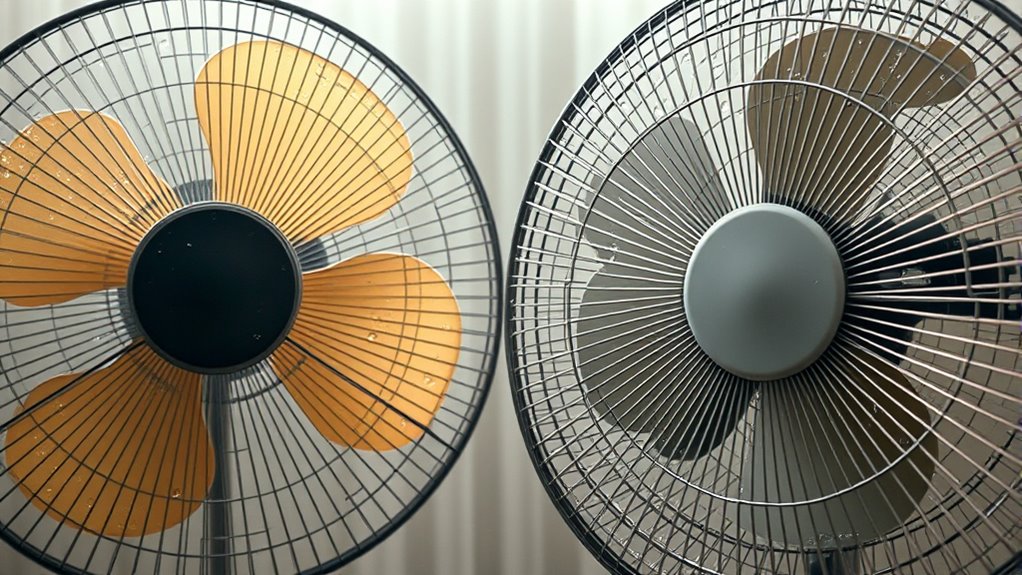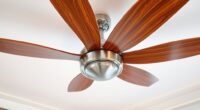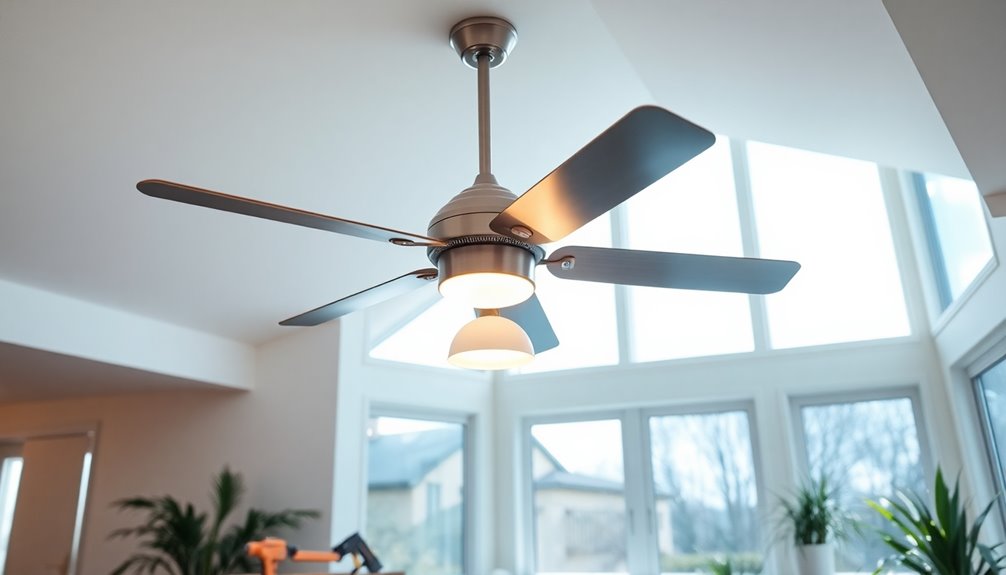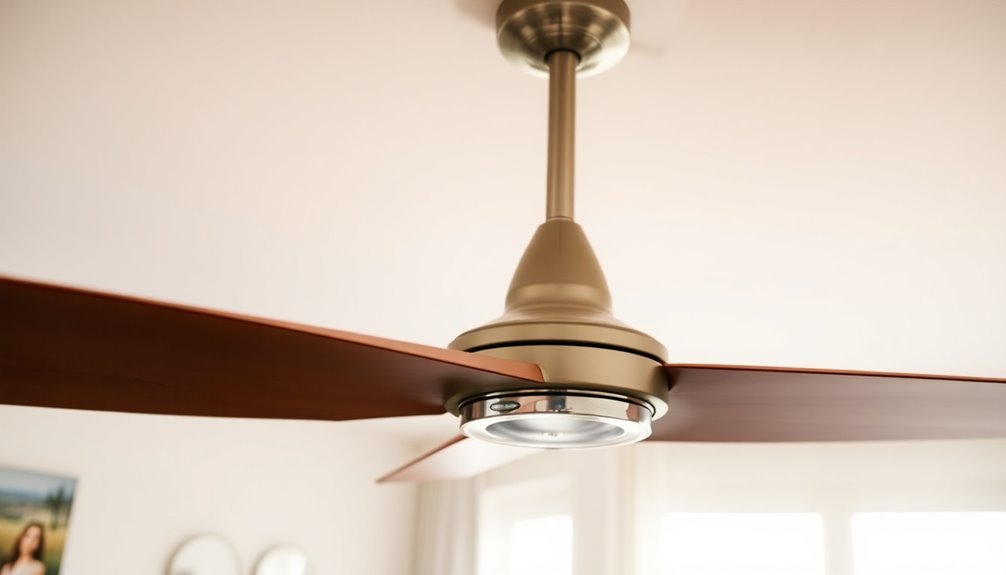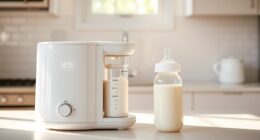Humidity impacts your fan’s efficiency by changing air density and heat dissipation. When humidity is high, the air becomes less dense, so your fan has to work harder to circulate it, increasing energy use. High moisture levels can also cause motor overheating and wear due to moisture buildup and corrosion. Conversely, dry air helps your fan operate more smoothly and efficiently. To understand how to optimize performance across different humidity levels, keep exploring these factors further.
Key Takeaways
- Increased humidity decreases air density, reducing fan load and overall efficiency.
- High moisture levels can cause motor overheating and damage, impairing fan performance.
- Humidity promotes corrosion and wear on fan components, decreasing lifespan and reliability.
- Moisture inside motors traps heat, lowering cooling efficiency and risking thermal failure.
- Proper humidity control enhances airflow effectiveness and reduces energy consumption.
The Basics of Fan Operation and Air Circulation
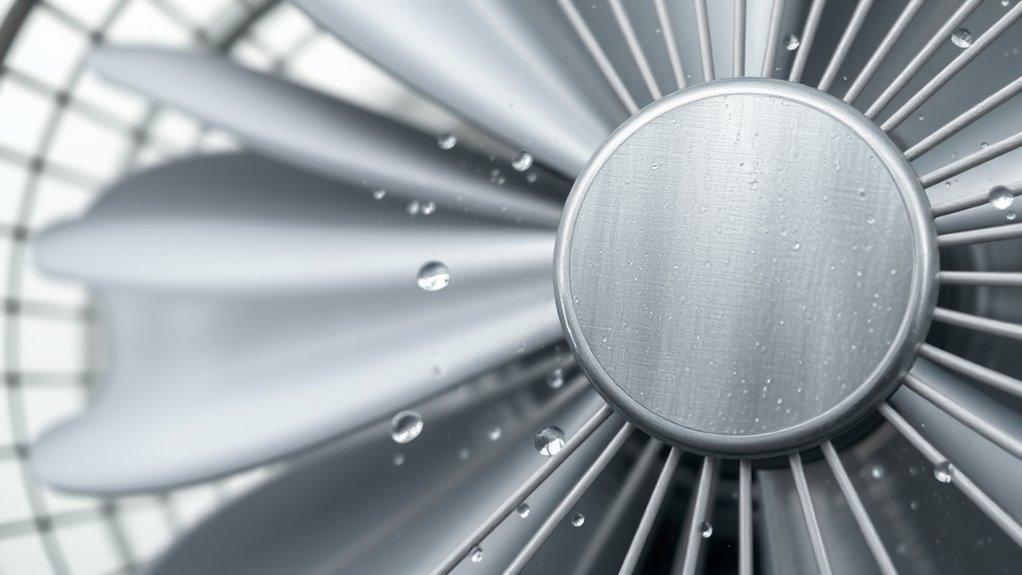
Fans work by moving air to create a breeze that cools the environment and improves air circulation. The key to their effectiveness lies in fan blade design. Different blade shapes and angles influence airflow patterns, determining how air is directed throughout a space. For example, blades with a wider sweep can generate more airflow, while those with specific pitch angles optimize circulation. As the fan spins, it pushes air forward, creating a pattern that helps ventilate and cool rooms efficiently. Understanding how blade design impacts airflow patterns allows you to choose fans that better suit your space. Properly designed blades ensure consistent air movement, reducing hotspots and enhancing overall comfort. Additionally, fan blade design directly affects how well your fan circulates air, and airflow efficiency can be improved by selecting blades with optimal geometry. The materials used in blade construction also influence durability and performance, further impacting overall fan efficiency.
How Humidity Levels Affect Air Density and Fan Load
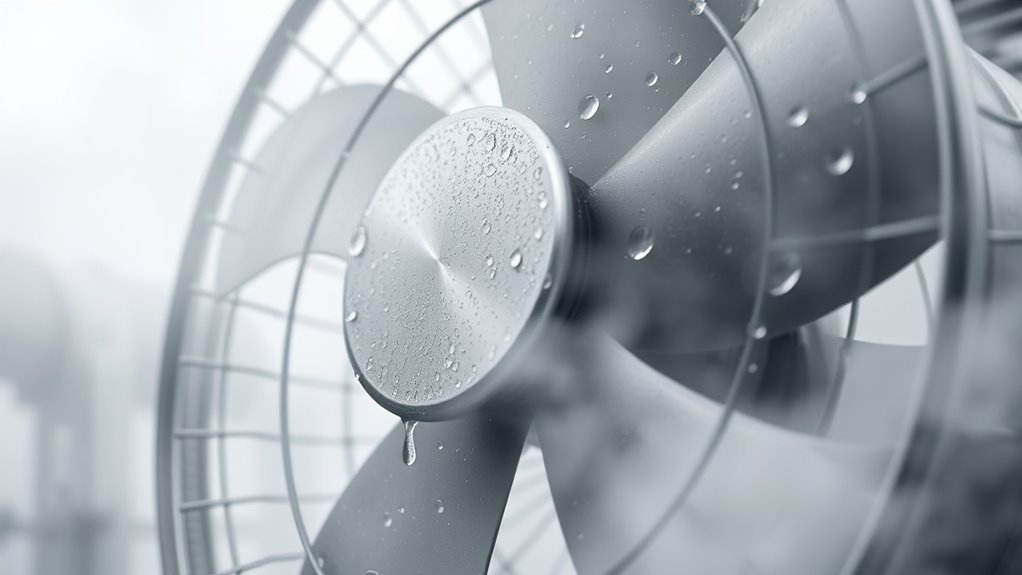
When humidity rises, the air becomes less dense, which can reduce the load on your fan. Conversely, dry air is denser, making the fan work harder to circulate it. Understanding these changes helps you optimize your fan’s power usage and efficiency. Additionally, tuning your fan system can further improve its performance under varying humidity conditions. For example, in environments such as water parks, managing humidity levels can significantly enhance cooling systems and energy consumption. Using indoor plants, like the Snake Plant or Peace Lily, can also help regulate humidity levels naturally, contributing to more efficient fan operation.
Air Density Changes
As humidity levels increase, the density of the air decreases because water vapor replaces some of the heavier nitrogen and oxygen molecules. This change affects fan performance, making it harder to move air efficiently. By monitoring humidity measurement and dew point analysis, you can better understand how moist conditions influence air density. The airflow efficiency of a fan diminishes as air density drops, leading to increased energy consumption and wear. Additionally, changes in air density due to humidity can impact energy efficiency and operational costs of fans in various settings. The table below shows how different humidity levels impact air density and fan load:
| Humidity Level | Air Density | Fan Load |
|---|---|---|
| Low | Higher | Lower |
| Moderate | Moderate | Moderate |
| High | Lower | Higher |
| Very High | Much lower | Much higher |
Understanding these shifts helps optimize fan operation and reduce costs. Recognizing how humidity levels influence air density is crucial for designing more efficient ventilation systems and reducing energy waste.
Fan Power Variations
Humidity levels directly influence air density, which in turn affects how much power your fan requires to operate efficiently. When humidity is high, air becomes less dense, meaning your fan needs to work harder to move the same volume of air. Proper humidity control helps maintain consistent air density, reducing unnecessary fan load and energy consumption. In ventilation design, understanding these variations allows you to maximize fan sizing and operation, ensuring efficient airflow without overexertion. Conversely, low humidity increases air density, which can also impact fan performance. By managing humidity levels effectively, you minimize power fluctuations caused by changing air properties. This balance enhances overall system efficiency, prolongs equipment lifespan, and reduces operational costs. Proper humidity control is essential for stable fan power and ideal ventilation. Additionally, awareness of environmental factors, such as cultural narratives and industry trends, can inform better HVAC strategies to optimize performance and energy savings. Recognizing the importance of air quality standards can further improve system design and energy management. For example, implementing humidity sensors can provide real-time data to optimize fan operation based on current conditions.
The Impact of High Humidity on Fan Motor Performance
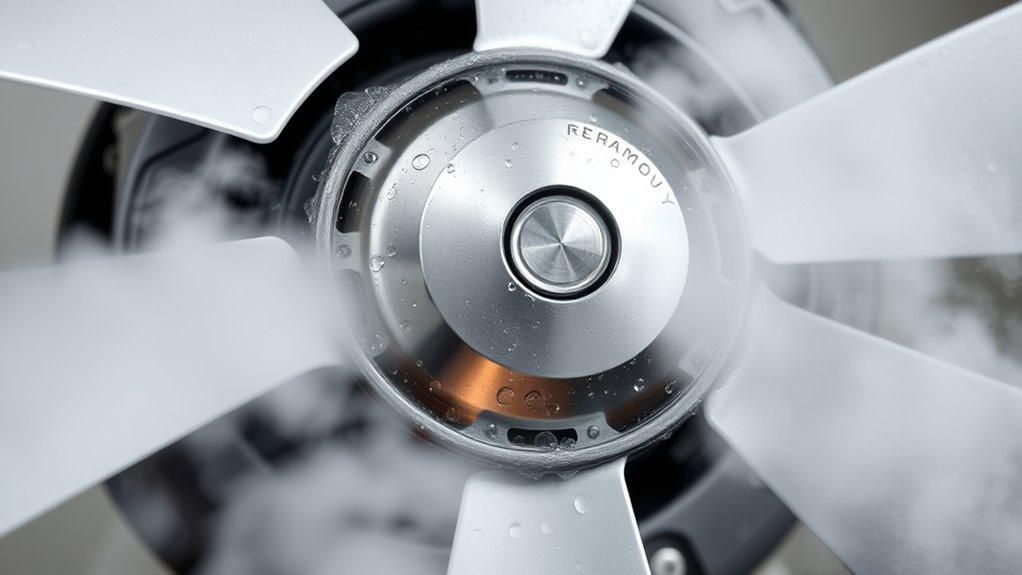
High humidity can cause your fan motor to overheat, risking damage and reduced lifespan. It also hampers cooling efficiency, making the system work harder than necessary. Additionally, increased moisture accelerates mechanical wear, leading to more frequent repairs. Implementing reliable monitoring systems can further prevent overheating and mechanical issues caused by humidity. Incorporating conflict resolution skills into maintenance routines can help address issues promptly before they escalate.
Motor Overheating Risks
When moisture levels rise considerably, fan motors are at greater risk of overheating, which can compromise their performance and longevity. High humidity causes moisture to accumulate inside the motor housing, increasing heat retention. Poor fan blade design can exacerbate this issue by creating uneven airflow, trapping heat near critical components. To prevent overheating, modern systems incorporate humidity sensors that monitor moisture levels in real time. These sensors can trigger adjustments, like reducing motor load or activating cooling mechanisms, helping to avoid thermal stress. Without proper safeguards, sustained high humidity can lead to insulation breakdown and motor failure. Being aware of these risks allows you to choose fans with suitable fan blade design and humidity monitoring features, ensuring reliable operation even in humid environments. Additionally, understanding how humidity impacts fan efficiency can guide you in selecting the most appropriate equipment for your needs.
Reduced Cooling Efficiency
Elevated moisture levels can substantially diminish a fan motor’s cooling effectiveness, causing it to operate less efficiently. When humid air surrounds the fan, it hampers heat dissipation from the motor’s components. This moisture can lead to condensation buildup on electrical parts, reducing heat transfer and causing the motor to run hotter. As a result, the fan struggles to maintain peak performance, decreasing its cooling capacity. The increased humidity impairs airflow around the motor, making it harder for heat to escape. Over time, this reduced cooling efficiency can cause overheating and further damage. Understanding how humidity affects mechanical systems is crucial for maintaining optimal fan performance. Proper maintenance and monitoring can help prevent issues related to high humidity and extend the lifespan of your fan. Additionally, controlling environmental conditions in the space where the fan operates can significantly improve its efficiency and longevity. To maintain high performance, it’s essential to control humidity levels and prevent excessive moisture from accumulating on or inside the fan motor.
Increased Mechanical Wear
Increased humidity accelerates mechanical wear on fan motors by promoting corrosion and rust on moving parts. This leads to lubrication degradation, causing components to run less smoothly. As corrosion risks rise, your fan’s motor faces added stress, reducing its lifespan. To understand the impact, consider:
- Lubrication breakdown due to moisture, increasing friction.
- Rust formation on bearings and shafts, impairing movement.
- Corrosion of electrical contacts, risking short circuits.
- Accelerated wear on gears and rotors from increased friction and corrosion.
- The presence of moisture can also lead to electrical malfunctions, further compromising fan performance. Additionally, high humidity can hinder proper heat dissipation, resulting in overheating and further damage to motor components.
These factors combine to diminish motor efficiency and reliability. Regular maintenance and protective coatings can mitigate these effects, but high humidity remains a significant threat to your fan’s mechanical integrity.
Dry Conditions and Their Effect on Fan Efficiency
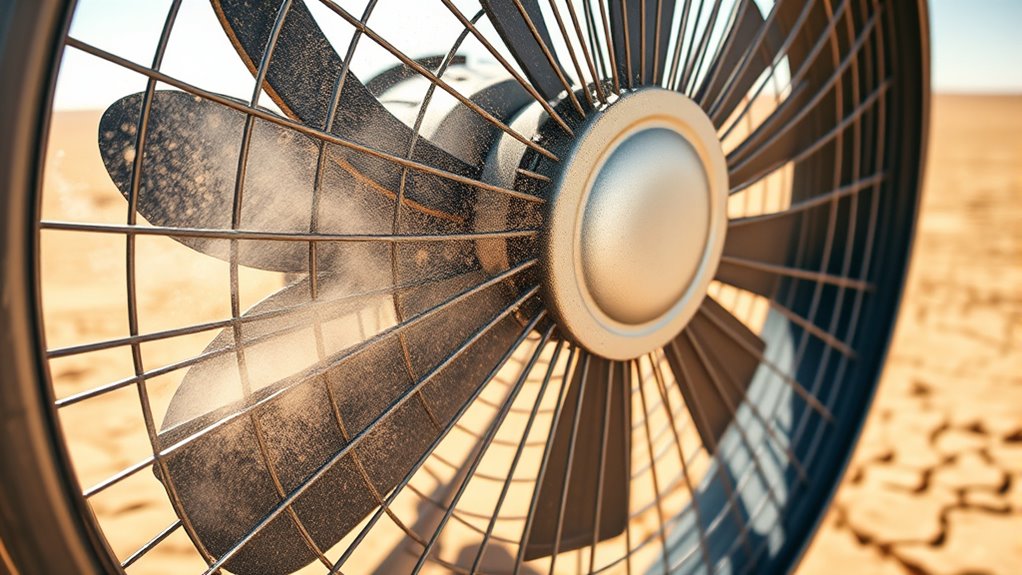
Dry conditions can considerably reduce fan efficiency by causing air to become less humid, which affects the fan’s ability to circulate air effectively. When humidity levels drop, fans may struggle to move air smoothly, leading to decreased performance. Installing humidity sensors helps monitor moisture levels, alerting you when dehumidification systems are needed. These systems remove excess moisture, maintaining ideal humidity for efficient airflow. Without proper humidity control, the air becomes too dry, increasing static electricity and reducing the fan’s capacity to generate airflow. Ensuring balanced humidity levels supports better fan operation, prevents unnecessary wear, and maintains consistent airflow. By managing dry conditions proactively, you’ll ensure your fans operate at peak efficiency and extend their lifespan.
Energy Consumption Changes in Different Humidity Environments
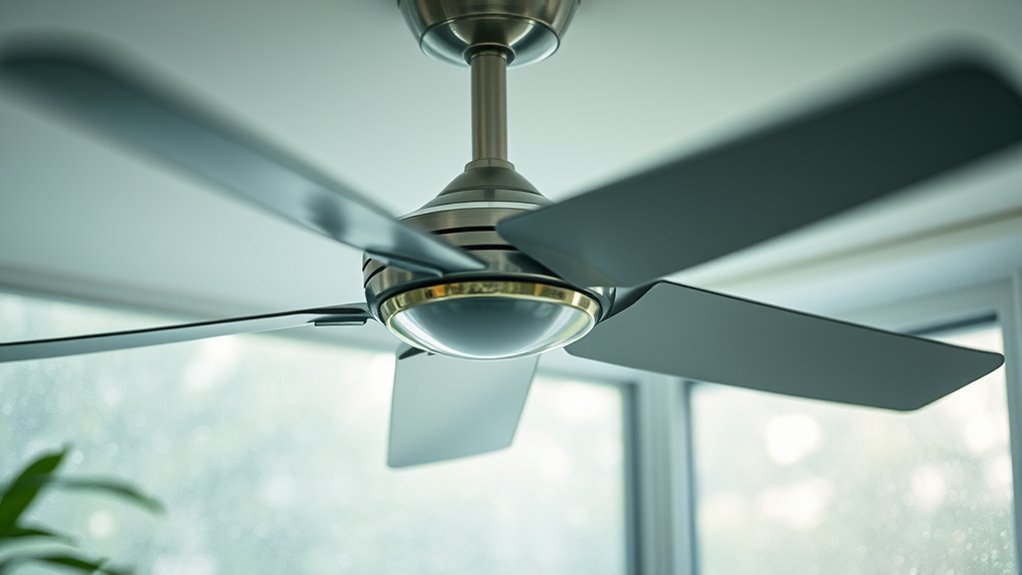
Humidity levels substantially influence the energy your fans consume during operation. In high humidity environments, your fans work harder to overcome moisture resistance, increasing energy use. Conversely, in dry conditions, they operate more efficiently. Proper humidity control through dehumidification methods can reduce overall energy consumption by optimizing airflow and reducing strain on the motor. Here are some key points:
- High humidity demands more energy for dehumidification, increasing fan workload.
- Low humidity environments allow fans to operate with less effort, saving energy.
- Effective humidity control minimizes the need for continuous fan operation.
- Choosing suitable dehumidification methods can stabilize humidity levels and reduce power consumption.
Adjusting humidity levels not only improves comfort but also enhances fan efficiency by preventing unnecessary energy expenditure.
Strategies to Optimize Fan Performance Across Humidity Levels
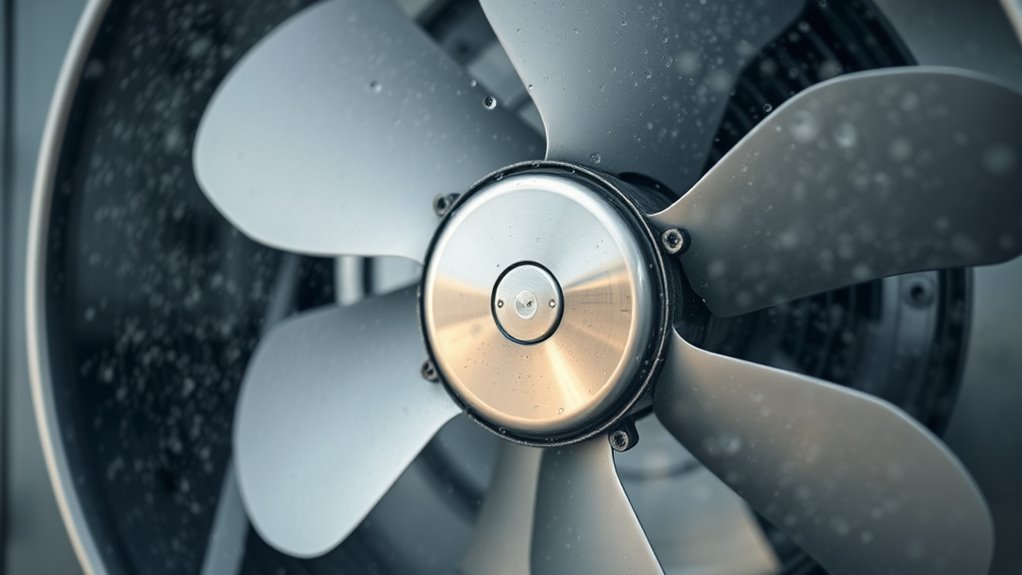
To optimize fan performance across varying humidity levels, you should implement adaptive strategies that adjust operation based on environmental conditions. Using humidity sensors allows you to monitor moisture levels in real-time, providing critical data to fine-tune fan activity. With this information, you can deploy targeted ventilation strategies that respond dynamically—reducing airflow when humidity is high to prevent excess moisture buildup or increasing it during dry periods to improve air quality. These adjustments help maintain ideal indoor conditions while minimizing energy waste. Incorporating humidity sensors into your system enables precise control, ensuring your fans operate efficiently regardless of humidity fluctuations. Ultimately, adaptive ventilation strategies not only improve comfort but also enhance the longevity and performance of your fans.
Selecting Fans Suitable for Varying Humidity Conditions
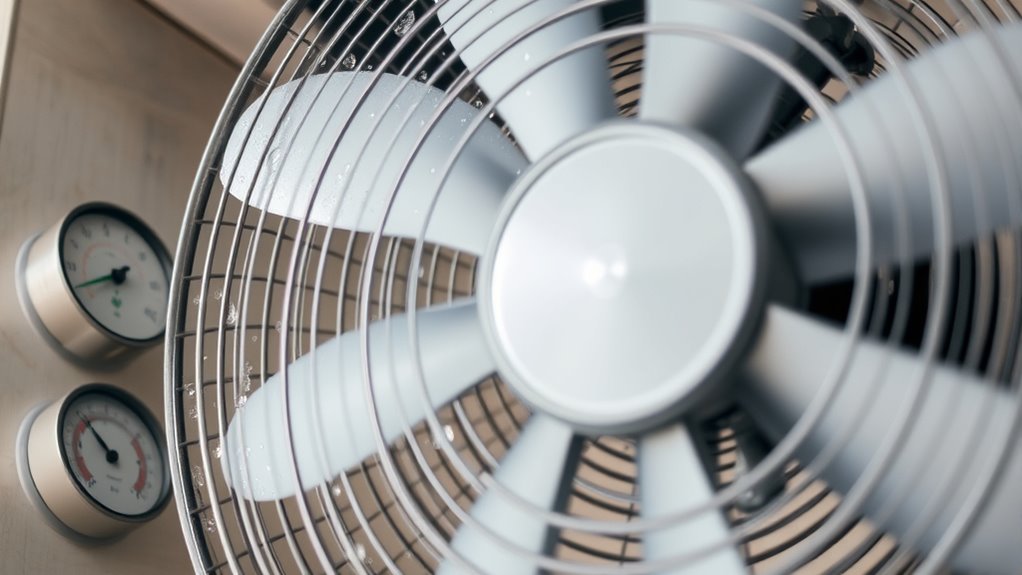
Choosing the right fans for environments with varying humidity levels requires understanding how different designs and materials perform under moisture exposure. To guarantee peak performance, focus on key factors:
Selecting fans with moisture-resistant features ensures optimal performance in humid environments.
- Select fans with moisture resistant materials to prevent corrosion and degradation.
- Use humidistat selection to automatically adjust fan operation based on humidity levels.
- Opt for fans with sealed motors to protect electrical components from moisture damage.
- Consider corrosion-resistant coatings or finishes to extend the fan’s lifespan in humid conditions.
Frequently Asked Questions
How Does Humidity Affect Fan Noise Levels?
You might notice that humidity affects fan noise levels by causing noise amplification and vibration increase. When humidity is high, moisture can make fan components more prone to vibrations, leading to louder operation. The increased vibration amplifies noise, making the fan sound louder than usual. So, in humid conditions, expect your fan to produce more noise due to these effects, which can impact overall comfort and quietness in your space.
Can Humidity Cause Corrosion in Fan Components?
Humidity can cause corrosion in fan components, turning metal parts rusty and weakening their structure. While corrosion prevention measures like coatings and proper material choices are essential, humidity control is equally vital. By maintaining ideal humidity levels, you prevent moisture buildup that accelerates corrosion. So, managing humidity not only preserves fan longevity but also reduces maintenance costs, ensuring your equipment operates smoothly and efficiently over time.
Does Humidity Influence the Lifespan of a Fan Motor?
Humidity definitely influences the lifespan of your fan motor. When moisture builds up inside, it increases the corrosion risk, which can damage motor components over time. This ongoing moisture exposure causes parts to wear down faster, leading to potential failures. To extend your fan’s life, make certain proper ventilation and regular maintenance, especially in humid environments, to minimize moisture buildup and protect your motor from corrosion and other damage.
Are There Specific Fan Types Best Suited for Humid Environments?
In a humid environment, your fan selection becomes a vital puzzle piece, like choosing the right sail for a stormy sea. Opt for fans with corrosion-resistant materials, such as stainless steel or plastic, that brave humidity without rusting. Look for models with sealed motors and efficient airflow. These fans stand strong against moisture, ensuring you stay cool without worrying about rust or breakdowns in your humid environment.
How Quickly Does Humidity Change Impact Fan Efficiency?
Humidity fluctuations can quickly affect fan efficiency because increased moisture absorption in the air reduces airflow and cooling performance. You might notice a drop in efficiency within minutes of a sudden change in humidity levels. As humidity rises, fans work harder to circulate air, which can strain motors and decrease longevity. Monitoring humidity levels helps you adjust settings or choose suitable fans to maintain ideal performance during such fluctuations.
Conclusion
Understanding how humidity affects fan efficiency is like tuning an instrument—you’ll get better performance when you adapt. Whether the air’s thick or dry, adjusting your fan choices and settings ensures smooth sailing. Keep an eye on humidity levels, and you’ll keep your fan running at its best, saving energy like a well-oiled machine. Mastering this balance lets you breathe easier, knowing your fan’s working just right, no matter the weather.
